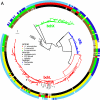High ratio of bacteriochlorophyll biosynthesis genes to chlorophyll biosynthesis genes in bacteria of humic lakes
- PMID: 19801478
- PMCID: PMC2786518
- DOI: 10.1128/AEM.00960-09
High ratio of bacteriochlorophyll biosynthesis genes to chlorophyll biosynthesis genes in bacteria of humic lakes
Abstract
Recent studies highlight the diversity and significance of marine phototrophic microorganisms such as picocyanobacteria, phototrophic picoeukaryotes, and bacteriochlorophyll- and rhodopsin-holding phototrophic bacteria. To assess if freshwater ecosystems also harbor similar phototroph diversity, genes involved in the biosynthesis of bacteriochlorophyll and chlorophyll were targeted to explore oxygenic and aerobic anoxygenic phototroph composition in a wide range of lakes. Partial dark-operative protochlorophyllide oxidoreductase (DPOR) and chlorophyllide oxidoreductase (COR) genes in bacteria of seven lakes with contrasting trophic statuses were PCR amplified, cloned, and sequenced. Out of 61 sequences encoding the L subunit of DPOR (L-DPOR), 22 clustered with aerobic anoxygenic photosynthetic bacteria, whereas 39 L-DPOR sequences related to oxygenic phototrophs, like cyanobacteria, were observed. Phylogenetic analysis revealed clear separation of these freshwater L-DPOR genes as well as 11 COR gene sequences from their marine counterparts. Terminal restriction fragment length analysis of L-DPOR genes was used to characterize oxygenic aerobic and anoxygenic photosynthesizing populations in 20 lakes differing in physical and chemical characteristics. Significant differences in L-DPOR community composition were observed between dystrophic lakes and all other systems, where a higher proportion of genes affiliated with aerobic anoxygenic photosynthetic bacteria was observed than in other systems. Our results reveal a significant diversity of phototrophic microorganisms in lakes and suggest niche partitioning of oxygenic and aerobic anoxygenic phototrophs in these systems in response to trophic status and coupled differences in light regime.
Figures




Similar articles
-
Discovery of the first light-dependent protochlorophyllide oxidoreductase in anoxygenic phototrophic bacteria.Mol Microbiol. 2014 Sep;93(5):1066-78. doi: 10.1111/mmi.12719. Epub 2014 Aug 5. Mol Microbiol. 2014. PMID: 25039543
-
Evolution of light-independent protochlorophyllide oxidoreductase.Protoplasma. 2019 Mar;256(2):293-312. doi: 10.1007/s00709-018-1317-y. Epub 2018 Oct 6. Protoplasma. 2019. PMID: 30291443 Review.
-
The trouble with oxygen: The ecophysiology of extant phototrophs and implications for the evolution of oxygenic photosynthesis.Free Radic Biol Med. 2019 Aug 20;140:233-249. doi: 10.1016/j.freeradbiomed.2019.05.003. Epub 2019 May 9. Free Radic Biol Med. 2019. PMID: 31078729 Review.
-
Effects of gilvin on the composition and dynamics of metalimnetic communities of phototrophic bacteria in freshwater North-American lakes.J Appl Microbiol. 1998 Dec;85 Suppl 1:138S-150S. doi: 10.1111/j.1365-2672.1998.tb05293.x. J Appl Microbiol. 1998. PMID: 21182703
-
Light-dependent and light-independent protochlorophyllide oxidoreductases in the chromatically adapting cyanobacterium Fremyella diplosiphon UTEX 481.Plant Cell Physiol. 2009 Aug;50(8):1507-21. doi: 10.1093/pcp/pcp095. Epub 2009 Jun 27. Plant Cell Physiol. 2009. PMID: 19561333
Cited by
-
Temporal changes and altitudinal distribution of aerobic anoxygenic phototrophs in mountain lakes.Appl Environ Microbiol. 2013 Oct;79(20):6439-46. doi: 10.1128/AEM.01526-13. Epub 2013 Aug 16. Appl Environ Microbiol. 2013. PMID: 23956384 Free PMC article.
-
Dissolved organic carbon as major environmental factor affecting bacterioplankton communities in mountain lakes of eastern Japan.Microb Ecol. 2012 Apr;63(3):496-508. doi: 10.1007/s00248-011-9983-8. Epub 2011 Nov 23. Microb Ecol. 2012. PMID: 22109097
-
Patterns in Abundance, Cell Size and Pigment Content of Aerobic Anoxygenic Phototrophic Bacteria along Environmental Gradients in Northern Lakes.PLoS One. 2015 Apr 30;10(4):e0124035. doi: 10.1371/journal.pone.0124035. eCollection 2015. PLoS One. 2015. PMID: 25927833 Free PMC article.
-
Trajectories of freshwater microbial genomics and greenhouse gas saturation upon glacial retreat.Nat Commun. 2023 Jun 3;14(1):3234. doi: 10.1038/s41467-023-38806-w. Nat Commun. 2023. PMID: 37270637 Free PMC article.
-
Novel Autotrophic Organisms Contribute Significantly to the Internal Carbon Cycling Potential of a Boreal Lake.mBio. 2018 Aug 14;9(4):e00916-18. doi: 10.1128/mBio.00916-18. mBio. 2018. PMID: 30108167 Free PMC article.
References
-
- Béja, O., L. Aravind, E. V. Koonin, M. T. Suzuki, A. Hadd, L. P. Nguyen, S. B. Jovanovich, C. M. Gates, R. A. Feldman, J. L. Spudich, E. N. Spudich, and E. F. DeLong. 2000. Bacterial rhodopsin: evidence for a new type of phototrophy in the sea. Science 289:1902-1906. - PubMed
-
- Béja, O., J. L. Spudich, E. N. Spudich, M. Leclerk, and E. F. DeLong. 2001. Proteorhodopsin phototrophy in the ocean. Nature 411:786-789. - PubMed
-
- Béja, O., M. T. Suzuki, J. F. Heidelberg, W. C. Nelsson, C. M. Preston, T. Hamada, J. A. Elsen, C. M. Fraser, and E. F. DeLong. 2002. Unsuspected diversity among marine aerobic anoxygenic phototrophs. Nature 415:7630-7633. - PubMed
-
- Bertilsson, S., R. Stepanauskas, R. Cuadros-Hanson, W. Granéli, J. Wikner, and L. Tranvik. 1999. Photochemically induced changes in bioavailable carbon and nitrogen pools in a boreal watershed. Aquat. Microb. Ecol. 19:47-56.
-
- Bollivar, D. W., J. Y. Suzuki, J. T. Beatty, J. M. Dobrowolski, and C. E. Bauer. 1994. Directed mutational analysis of bacteriochlorophyll-alpha biosynthesis in Rhodobacter capsulate. J. Mol. Biol. 237:622-640. - PubMed
Publication types
MeSH terms
Substances
Associated data
- Actions
- Actions
- Actions
- Actions
- Actions
- Actions
- Actions
- Actions
- Actions
- Actions
- Actions
- Actions
- Actions
- Actions
- Actions
- Actions
- Actions
- Actions
- Actions
- Actions
- Actions
- Actions
- Actions
- Actions
- Actions
- Actions
- Actions
- Actions
- Actions
- Actions
- Actions
- Actions
- Actions
- Actions
- Actions
- Actions
- Actions
- Actions
- Actions
- Actions
- Actions
- Actions
- Actions
- Actions
- Actions
- Actions
- Actions
- Actions
- Actions
- Actions
- Actions
- Actions
- Actions
- Actions
- Actions
- Actions
- Actions
- Actions
- Actions
- Actions
- Actions
- Actions
- Actions
- Actions
- Actions
- Actions
- Actions
- Actions
- Actions
- Actions
- Actions
- Actions
- Actions
- Actions
- Actions
- Actions
- Actions
- Actions
- Actions
- Actions
- Actions
- Actions
- Actions
- Actions
- Actions
- Actions
- Actions
- Actions
- Actions
- Actions
- Actions
- Actions
LinkOut - more resources
Full Text Sources

